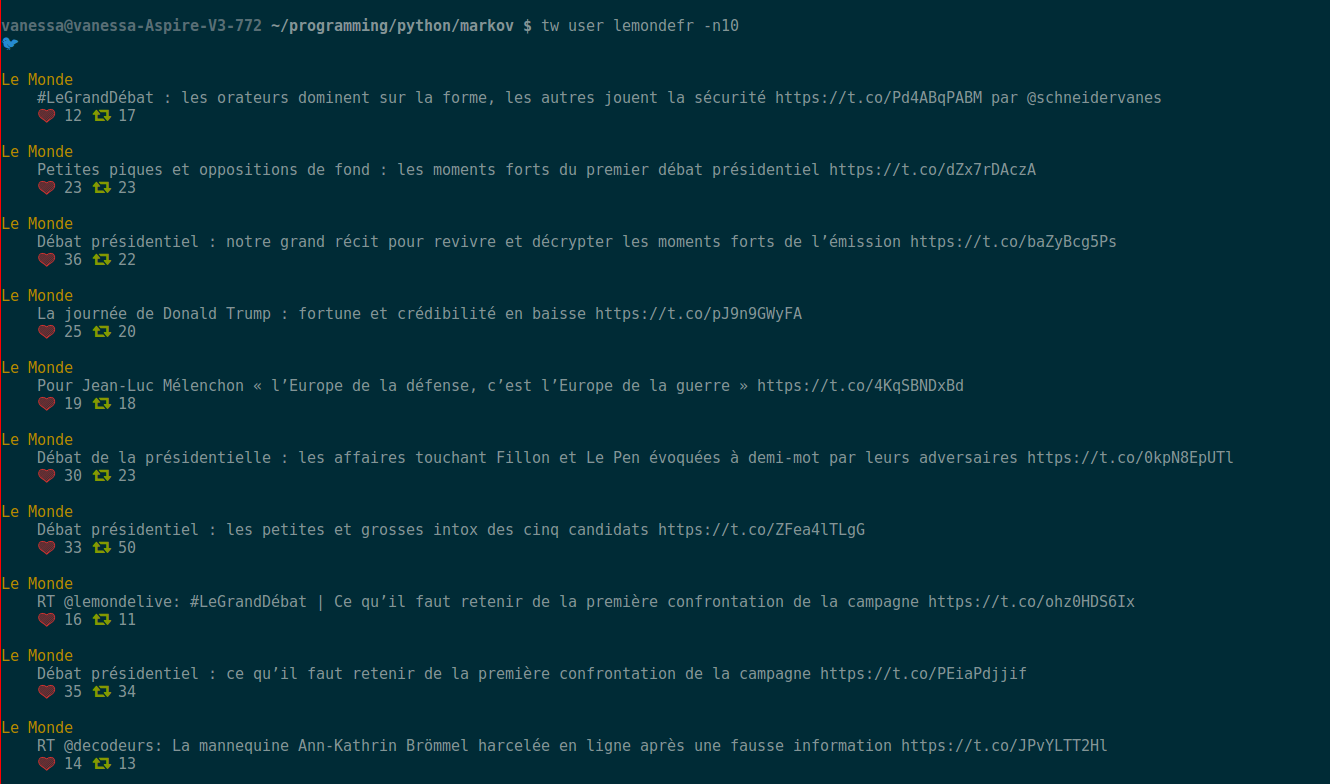# Command Line Interface Tweeter (rust version)
Screenshot in alacritty:

The rust version of this tool is somewhat faster than its [haskell
counterpart](https://github.com/vmchale/command-line-tweeter), but the haskell
one has a few more features.
Reasons to use clit-rs:
- Faster than other tools ([t](https://github.com/sferik/t), [rainbowstream](https://github.com/DTVD/rainbowstream)
,[clit](https://github.com/vmchale/command-line-tweeter)
,[oysttyer](https://github.com/oysttyer/oysttyer))
- Lightweight (5MB, low CPU/memory usage)
- Unobtrusive
- Support for colored output.
- Can be used in scripts
- You know rust and like being able to extend your tools.
- You want something that can be called from
[vim](https://github.com/vmchale/vim-twitter)
- You want a twitter library for rust.
- BSD3 licensed
Reasons not to use clit-rs:
- Many features are still in development
- Fewer features than [rainbowstream](https://github.com/DTVD/rainbowstream),
[t](https://github.com/sferik/t), or [oysttyer](https://github.com/oysttyer/oysttyer)
- You want to extend your tools in [haskell](https://github.com/vmchale/command-line-tweeter)
- You want "twitter in a terminal" that [rainbowtools](https://github.com/DTVD/rainbowstream)
or [oysttyer](https://github.com/oysttyer/oysttyer) provides.
## Config
Generate a token to authorize access to your twitter account by following the guide [here](https://dev.twitter.com/oauth/overview/application-owner-access-tokens)
Then place your API keys and OAuth tokens in a file (default is `$HOME/.cred`), separated by a line break:
```
api-key: API_KEY_HERE
api-sec: API_SECRET_HERE
tok: OAUTH_TOKEN_HERE
tok-sec: TOKEN_SECRET_HERE
```
Note that the labels must in the correct order, and separated from the keys with
whitespace.
## Installation
If you're on Linux/Windows the best way is probably to download the binaries
from the releases page [here](https://github.com/vmchale/clit-rs/releases).
Otherwise, you'll have to build from source. To build from source, install
[cargo](https://www.rustup.rs/) via rustup; on unix systems this is as simple as
```
Then type `cargo install clit-rs`.
## Use
### View Profiles
To get your profile, simply type:
```bash
$ tw user
```
To view a user's profile, type e.g.
```bash
$ tw user pinepapplesmear
```
If you have any problems along the way:
```bash
$ tw help
```
### Sending tweets
```bash
$ tw send "YOUR_TWEET_TEXT"
```
### Viewing your timeline
You can also use
```bash
$ tw view
```
to view your own timeline.
### Features
- [x] tweet
- [x] view timeline
- [x] view user profiles
- [x] output with id of tweet
- [x] delete tweet
- [x] retweet
- [x] reply to tweet
- [ ] display quoted tweets alongside
## Coloring
clit-rs respects the [CLICOLOR behavior](http://bixense.com/clicolors/) defined here.
If you wish to disable colorization,
```bash
$ export CLICOLOR=0
```
## Library
A library is included. It's fairly easy to use once you have the credentials set up, with three functions: one to post a status, one to get your timeline, and one to get a user profile.
### Haskell
There is a haskell version of this, with a binary and a library, available [here](https://github.com/vmchale/command-line-tweeter). The haskell library is more complete.